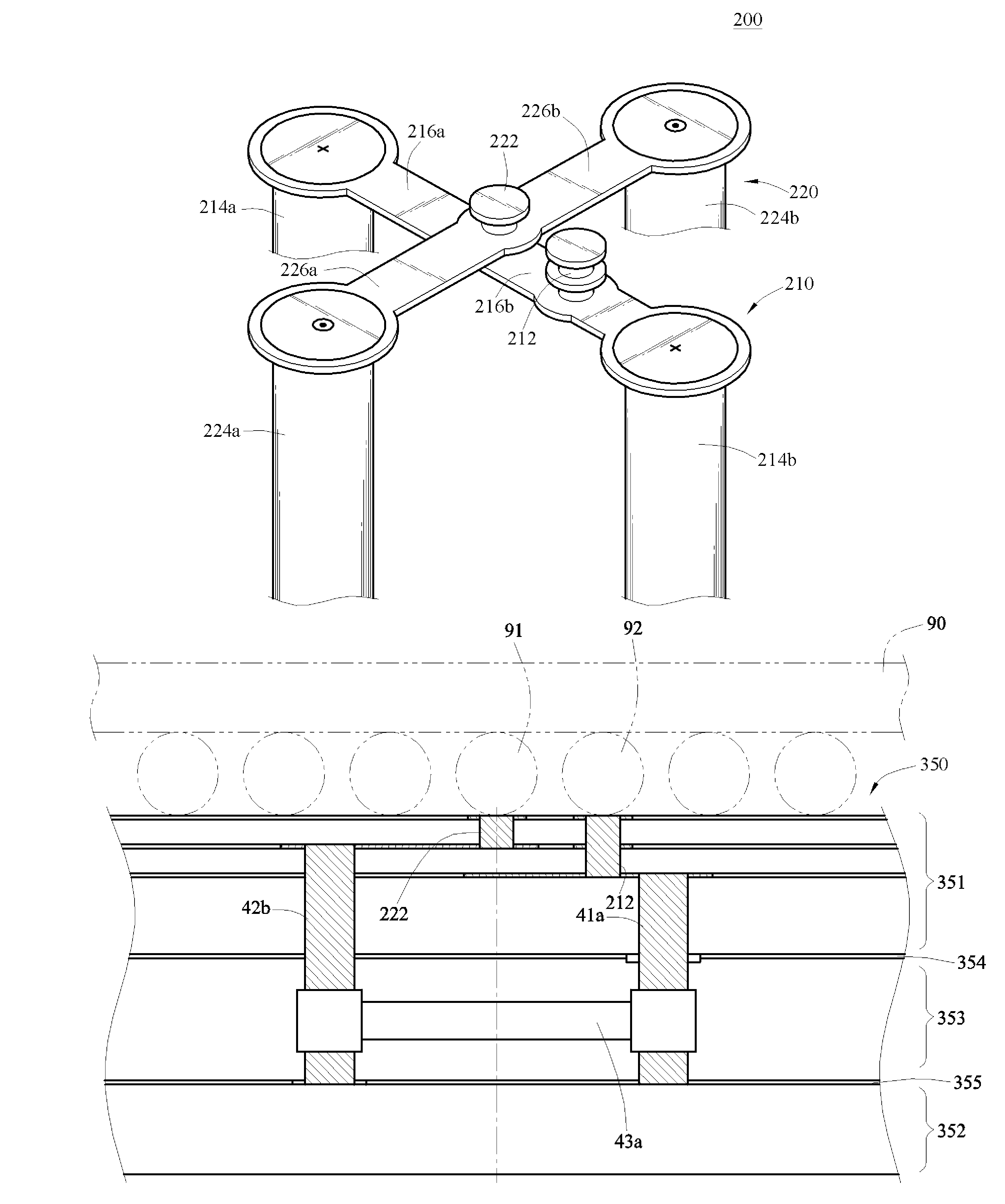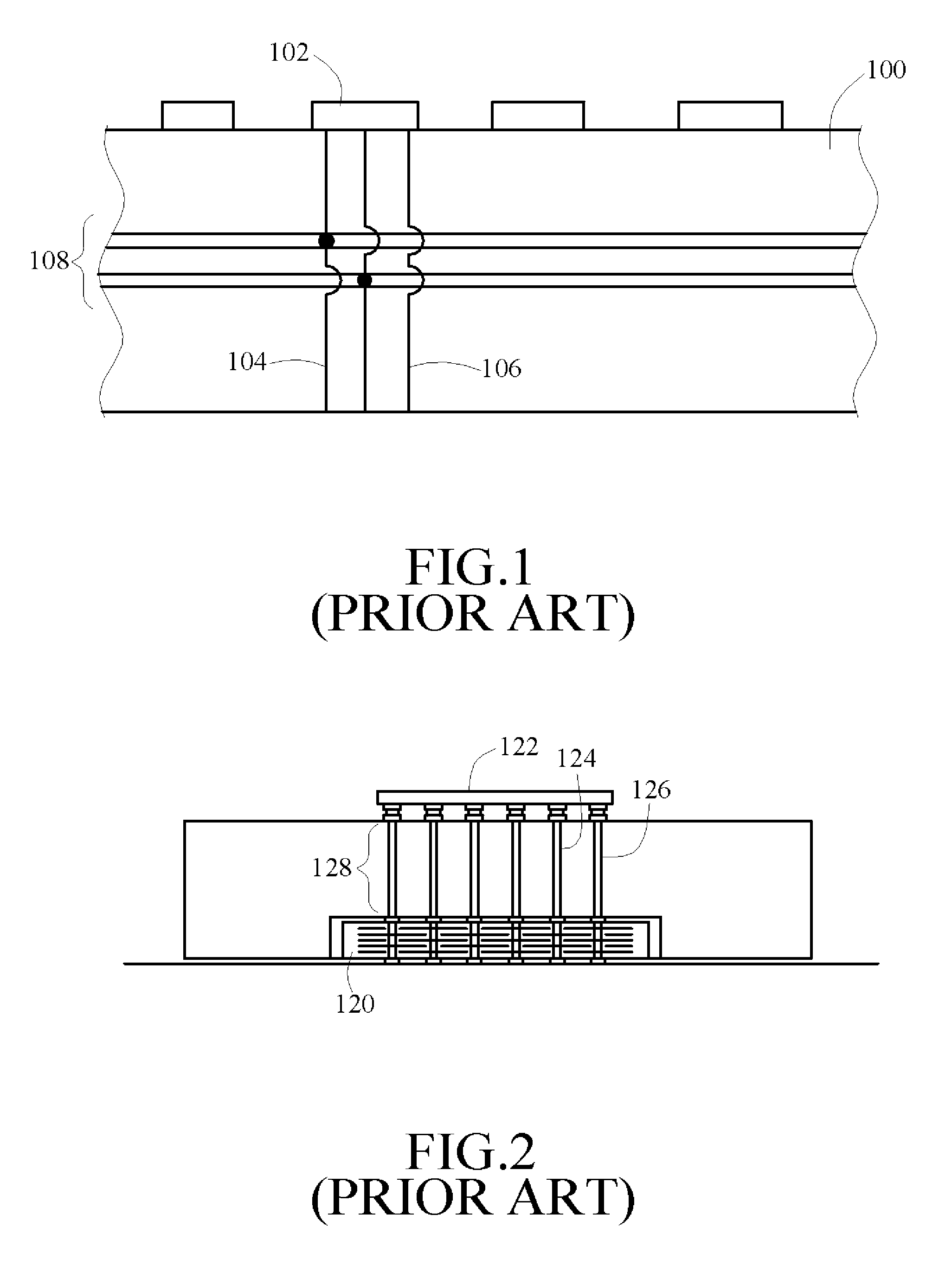Electrically conductive structure of circuit board and circuit board using the same
a technology of electrically conductive structure and circuit board, which is applied in the direction of cross-talk/noise/interference reduction, electrical apparatus contruction details, etc., can solve the problems of ineffective reduction of esl b>128/b> of feedthrough conductors marked at metal conductive structure in the drawing, unsatisfactory operation of electronic devices, and inability to effectively reduce esl b>128/b> of feedthrough
- Summary
- Abstract
- Description
- Claims
- Application Information
AI Technical Summary
Benefits of technology
Problems solved by technology
Method used
Image
Examples
first embodiment
[0034]Referring to FIGS. 5, 6 and 7, through the electrically conductive structure 200 of the first embodiment, at least one power contact 91 and at least one ground contact 92 of the electronic device 90 are electrically coupled to a power plane 302 and a ground plane 304 respectively in the circuit board 300. The electrically conductive structure 200 includes a first conductive structure 220 and a second conductive structure 210. The first conductive structure 220 has a first conducting section 222 electrically coupled to the power contact 91 at one end, and two (extending) first coupling sections 224a, 224b electrically connected to the first conducting section 222 at the other end. The two first coupling sections 224a, 224b are arranged in a pair, and the first coupling sections 224a, 224b are electrically connected to the power plane 302. The second conductive structure 210 has a second conducting section 212 electrically coupled to the ground contact 92 at one end, and two (ex...
second embodiment
[0046]FIG. 8 is a top view of the electrically conductive structure according to a Referring to FIG. 8, the electrically conductive structure 250 includes a first conductive structure 251 and a second conductive structure 255. The first conductive structure 251 has one first conducting section 252 and three first coupling sections 253a, 253b, 253c. The second conductive structure 255 has one second conducting section 256 and three second coupling sections 257a, 257b, 257c. The two first coupling sections 253a, 253b are arranged in pair, and the two second coupling sections 257a, 257b are also arranged in a pair. The two first coupling sections 253a, 253b in a pair and the two second coupling sections 257a, 257b in a pair are arranged in a staggered array, such that the effect of the magnetic flux cancellation may be achieved. The arrangement of the first coupling section 253c and the second coupling section 257c is not in a pair and not limited to that as shown in FIG. 8, and may b...
third embodiment
[0047]FIG. 9 shows the electrically conductive structure according to the present invention, which is applied in an electronic device having four power contacts and four ground contacts. Referring to FIG. 9, the electrically conductive structure 20 comprise four first conductive structures 21a, 21b, 21c, 21d and four second conductive structures 25a, 25b, 25c, 25d. Each first conductive structure 21a, 21b, 21c, 21d has one first conducting section 22a, 22b, 22c, 22d and two first coupling sections 23a, 24a, 23b, 24b, 23c, 24c, 23d, 24d. Each second conductive structure 25a, 25b, 25c, 25d also has one second conducting section 26a, 26b, 26c, 26d and two second coupling sections 27a, 28a, 27b, 28b, 27c, 28c, 27d, 28d. The four first conductive structures 21a, 21b, 21c, 21d and four second conductive structures 25a, 25b, 25c, 25d are not electrically connected. Actually, the four first conductive structures 21a, 21b, 21c, 21d are used to electrically connect the four power contacts of ...
PUM
 Login to View More
Login to View More Abstract
Description
Claims
Application Information
 Login to View More
Login to View More - R&D
- Intellectual Property
- Life Sciences
- Materials
- Tech Scout
- Unparalleled Data Quality
- Higher Quality Content
- 60% Fewer Hallucinations
Browse by: Latest US Patents, China's latest patents, Technical Efficacy Thesaurus, Application Domain, Technology Topic, Popular Technical Reports.
© 2025 PatSnap. All rights reserved.Legal|Privacy policy|Modern Slavery Act Transparency Statement|Sitemap|About US| Contact US: help@patsnap.com



